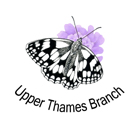 | Butterfly Conservation Saving butterflies, moths and our environment | Upper Thames Branch |  |
White-letter Hairstreak Project |
| The White-letter Hairstreak is a UK BAP priority species. Figures from the UK butterfly monitoring scheme show a population decline of 87% since 1976. The greatest factor in this decline was the loss of British Elms (the larval foodplant) due to Dutch Elm Disease (DED), caused by the fungus Ophiostoma novo-ulmi and spread by Elm Bark beetles (genus Scolytus). The aim of the project is to try and protect the White-letter Hairstreak from further decline in the UTB region. |
| There is some inspirational work already being done in this field, firstly by Andrew Brookes of BC Hampshire and IoW branch and secondly by David Herling of Resistant Elms. |
The White-letter Hairstreak project has two aims:
|
Finding New Colonies |
| If you would like to help it need not be too much of a commitment time-wise. Searching for new colonies is best done by looking for mature elms in April, when the seeds are on the tree. At this time of year they really stand out and it's easy to spot elm that you might otherwise overlook. Once you have your list of potential elms it's just a matter of going back during the flight season (end of June or beginning of July) armed with your binoculars and searching the tops of the elms. If the butterfly is there you should be able to see them in small spiralling flights in the canopy. How big an area you search is entirely up to you, from just your local park or where you walk the dog to a larger swathe of countryside, all results will help towards gaining an accurate picture of the White-letter Hairstreak population. If you find a suspected colony, or a single sighting, please send the date of the sighting, grid reference, location and recorder's name to @upperthames-butterflies.upperthames-butterflies.org.uk |
Elm Planting |
| This will be a case of getting permission from landowners to plant DED-resistant elms close to White-letter Hairstreak colonies. Each tree will be numbered and mapped and a record then kept of the variety of elm, year of planting etc. I also hope to find volunteers who would be willing to make an occasional visit to check on the young trees until they become established. We are not talking about large numbers of trees, just a few each year and would not expect people to travel far. If you might be able to help in any way, please contact me at @upperthames-butterflies.upperthames-butterflies.org.uk |
| Peter Cuss January 2016 |
Copyright © Butterfly Conservation Upper Thames Branch 2024
Privacy and Copyright Statement
Butterfly Conservation : Company limited by guarantee, registered in England (2206468)
Registered Office: Manor Yard, East Lulworth, Wareham, Dorset, BH20 5QP, Tel: 01929 400 209
Charity registered in England & Wales (254937) and in Scotland (SCO39268)
Privacy and Copyright Statement
Butterfly Conservation : Company limited by guarantee, registered in England (2206468)
Registered Office: Manor Yard, East Lulworth, Wareham, Dorset, BH20 5QP, Tel: 01929 400 209
Charity registered in England & Wales (254937) and in Scotland (SCO39268)
